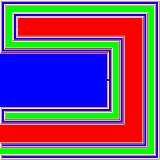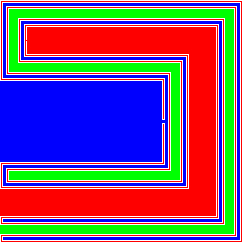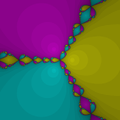
Lakes of Wada
Encyclopedia
In mathematics
, the lakes of Wada are three disjoint connected open set
s of the plane with the counterintuitive property that they all have the same boundary
.
More than two sets with the same boundary are said to have the Wada property; examples include Wada basins in dynamical system
s.
The lakes of Wada were introduced by , who credited the discovery to his teacher Takeo Wada
.
 The Lakes of Wada are formed by starting with an open unit square of dry land (homeomorphic to the plane), and then digging 3 lakes according to the following rule:
The Lakes of Wada are formed by starting with an open unit square of dry land (homeomorphic to the plane), and then digging 3 lakes according to the following rule:
After an infinite number of days, the three lakes are still disjoint connected open sets, and the remaining dry land is the boundary of each of the 3 lakes.
For example, the first five days might be (see the image on the right):
A variation of this construction can produce a countable infinite number of connected lakes with the same boundary: instead of extending the lakes in the order 1, 2, 0, 1, 2, 0, 1, 2, 0, ...., extend them in the order 0, 0, 1, 0, 1, 2, 0, 1, 2, 3, 0, 1, 2, 3, 4, ...and so on.
 Wada basins are certain special basins of attraction studied in the mathematics
Wada basins are certain special basins of attraction studied in the mathematics
of non-linear systems. A basin having the property that every neighborhood of every point on the boundary of that basin intersects at least three basins is called a Wada basin, or said to have the Wada property. Unlike the Lakes of Wada, Wada basins are often disconnected.
An example of Wada basins is given by the Newton–Raphson method
applied to a cubic polynomial with distinct roots, such as see the picture.
A physical system that demonstrates Wada basins is the pattern of reflections between three spheres in contact.
Mathematics
Mathematics is the study of quantity, space, structure, and change. Mathematicians seek out patterns and formulate new conjectures. Mathematicians resolve the truth or falsity of conjectures by mathematical proofs, which are arguments sufficient to convince other mathematicians of their validity...
, the lakes of Wada are three disjoint connected open set
Open set
The concept of an open set is fundamental to many areas of mathematics, especially point-set topology and metric topology. Intuitively speaking, a set U is open if any point x in U can be "moved" a small amount in any direction and still be in the set U...
s of the plane with the counterintuitive property that they all have the same boundary
Boundary (topology)
In topology and mathematics in general, the boundary of a subset S of a topological space X is the set of points which can be approached both from S and from the outside of S. More precisely, it is the set of points in the closure of S, not belonging to the interior of S. An element of the boundary...
.
More than two sets with the same boundary are said to have the Wada property; examples include Wada basins in dynamical system
Dynamical system
A dynamical system is a concept in mathematics where a fixed rule describes the time dependence of a point in a geometrical space. Examples include the mathematical models that describe the swinging of a clock pendulum, the flow of water in a pipe, and the number of fish each springtime in a...
s.
The lakes of Wada were introduced by , who credited the discovery to his teacher Takeo Wada
Takeo Wada
Takeo Wada was a Japanese mathematician working in topology, who suggested the Lakes of Wada....
.
Construction of the lakes of Wada

- On day n = 1, 2, 3,... extend lake n mod 3 (=0, 1, 2) so that it passes within a distance 1/n of all remaining dry land. This should be done so that the remaining dry land has connected interior, and each lake is open.
After an infinite number of days, the three lakes are still disjoint connected open sets, and the remaining dry land is the boundary of each of the 3 lakes.
For example, the first five days might be (see the image on the right):
- Dig a blue lake of width 1/3 passing within √2/3 of all dry land.
- Dig a red lake of width 1/32 passing within √2/32 of all dry land.
- Dig a green lake of width 1/33 passing within √2/33 of all dry land.
- Extend the blue lake by a channel of width 1/34 passing within √2/34 of all dry land. (Note the small channel connecting the thin blue lake to the thick one, near the middle of the image.)
- Extend the red lake by a channel of width 1/35 passing within √2/35 of all dry land. (Note the tiny channel connecting the thin red lake to the thick one, near the top left of the image.)
A variation of this construction can produce a countable infinite number of connected lakes with the same boundary: instead of extending the lakes in the order 1, 2, 0, 1, 2, 0, 1, 2, 0, ...., extend them in the order 0, 0, 1, 0, 1, 2, 0, 1, 2, 3, 0, 1, 2, 3, 4, ...and so on.
Wada basins

Mathematics
Mathematics is the study of quantity, space, structure, and change. Mathematicians seek out patterns and formulate new conjectures. Mathematicians resolve the truth or falsity of conjectures by mathematical proofs, which are arguments sufficient to convince other mathematicians of their validity...
of non-linear systems. A basin having the property that every neighborhood of every point on the boundary of that basin intersects at least three basins is called a Wada basin, or said to have the Wada property. Unlike the Lakes of Wada, Wada basins are often disconnected.
An example of Wada basins is given by the Newton–Raphson method
Newton's method
In numerical analysis, Newton's method , named after Isaac Newton and Joseph Raphson, is a method for finding successively better approximations to the roots of a real-valued function. The algorithm is first in the class of Householder's methods, succeeded by Halley's method...
applied to a cubic polynomial with distinct roots, such as see the picture.
A physical system that demonstrates Wada basins is the pattern of reflections between three spheres in contact.

